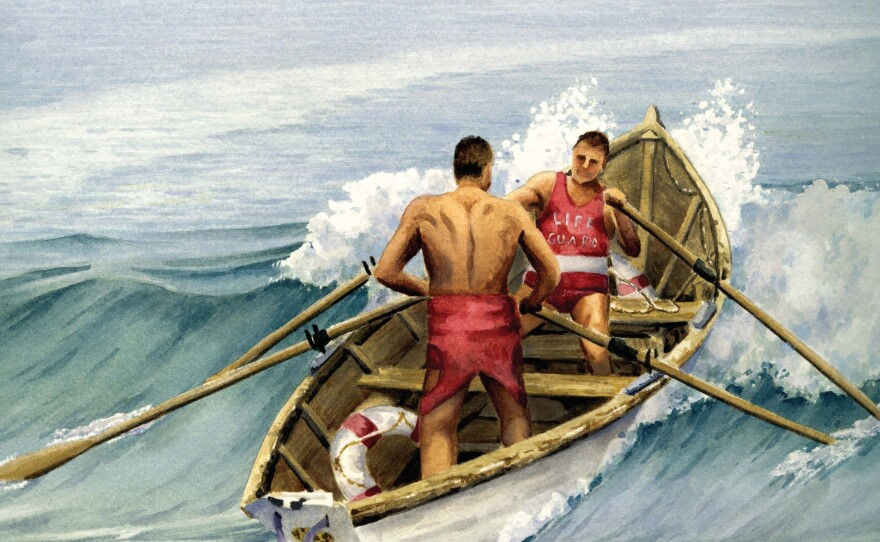The development of the lifeguard service in San Diego began slowly, in fits and starts since the late 1800s. It took a tragedy off the coast of Ocean Beach to really mark the start of the modern-day San Diego lifeguard service.
Thirteen people drowned on May 5, 1918 in a rip current event at Ocean Beach. Although San Diego first hired lifeguards in 1914, the 1918 tragedy is what led the city to allocate the necessary resources for the lifeguard service.
Michael Martino, former chief lifeguard for California State Parks, is author of a history of the lifeguards called “HELP! San Diego Lifeguards to the Rescue, A History of Their Service, Volume 1: 1868-1941.”
He said the Ocean Beach tragedy, "was the most catastrophic, single event drowning in San Diego's history."
Martino said he wrote the book for lifeguards, beach goers and the general public.
"My really big goal was, I want somebody with really no knowledge of the ocean to pick this book up and say this story is fantastic ... because what these men did and it's something that I think that all of us as San Diegans and people who enjoy the beach can be proud of because its not just about lifeguards, it's about how communities rallied and demanded safety for their families when they came out to the beach," he said.
Martino joins Midday Edition on Wednesday to discuss the book and the history of the lifeguard service.
>> This is KPBS Roundtable . I'm Maureen Cavanaugh. >> While we are reintroducing ourselves to the ocean, San Diego lifeguards will be on the lookout watching for anyone who is in danger. I was not always the case. The development of the lifeguard service began slowly since the late 1800s. It took a tragedy off the coast of Ocean Beach to Mark the start of the modern-day San Diego lifeguard service. Michael Martino, former chief lifeguard, has written a history of lifeguards called help, San Diego lifeguards to the rescue. Welcome to the program. This book began way back in the 1860s. Your chapter on that time is called citizen-rescuers. Can you tell us how that worked? Were there designated citizens safeguarding the beaches? >> There wasn't. People started coming to the ocean for recreation. Occasionally, they we get into trouble. They would be in a situation where they were drowning. Their only recourse would be if there was a fellow citizen who saw what was going on and made the decision to rescue them. I equated that to the story of a good Samaritan where you are at the mercy of a fellow citizen who made a choice to try and rescue you are not rescue you. >> Or who could or couldn't swim. >> Many times, people who couldn't swim still did it and you would have a double drowning or multiple fatalities. It was those type of events that got people to say, is there another way? Could we provide rescue equipment? That was the first step. Is our rescue equipment we could have available. Those where the baby steps that started and what happened is people would vandalize the equipment. It wasn't available or people didn't know how to use the equipment. I have a couple of stories and their about a robot that was available for making rescues. People try to use the boats, but they didn't have the skill. >> As we explain the idea of lifeguards, it took a tragedy to make city officials aware of the need for a well staffed live or -- lifeguard service in San Diego. >> It was a typical San Diego day, over 5000 soldiers and their families at Ocean Beach. What happened was there was only white -- one lifeguard working. About three, p.m., he went to contact a group of soldiers. Those soldiers were swimming out to a place called Wonderland point. He tried to tell them about the dangers but they were starting to comply, but one of the soldiers rallied the troops and said, don't listen to them. They swam off. What I said in the book, a proverbial snap of the finger, the tides were switching, the rip currents started pulling, the waves were coming in at 6-8 feet. All of the water that was in Mission Bay started flowing back out into tremendous rip currents. They were going in many directions. It became a catastrophic running event. He ultimately did his best, but there were police officers with prior lifeguarding experience I came to the eight. There is citizens that came to their aid. When it was done, after approximately two hours of rescuing, 13 people were missing, too were confirmed dead and 60 or more were rescued. It was the most catastrophic single event drowning in San Diego's history. That was the impetus that helped city leaders get together with community leaders and focus on beach safety and start to move in a more professional direction. It still wasn't the catchall and be-all. They got us moving in the right direction. >> You write how lifeguards have to have a deep knowledge of how the ocean behaves in order to anticipate how the problems can occur. Can you tell us more about that? >> We get the stereotype of it must be the greatest job in the world. And there's no doubt it is. But the perception is you get to sit up in the tower and soak in the sun and look out over the beautiful scenery. Occasionally you might make a rescue. But, lifeguards must have a much deeper and more concentrated knowledge of what's going on. That means, where are the rip currents? Where are the dangerous areas? Where are the deep spots? What is my tide doing today? Things that people may not think about, but I will look at a family who is coming in and you will look at their clothing. You will look at where they set their stuff down. Rip currents have a tendency to look like the most common areas. As the water moves out, they prevent the waves from breaking. Any times, families will put the beach blankets down right in front of the rip currents. A good lifeguard will not wait for that family go into the water. A good lifeguard will expand to them the dynamics of the situation and move them to a safer spot. A goal for a lifeguard is prevention. As the chief of state parks and lifeguard supervisor, I wanted to see my people making 30 times more safety contacts than rescues. I knew we are being active and productive. >> You have described rip currents in the book. You talked about set waves and these potentially life-threatening situations people can get into. I'm wondering, on a more Monday note, outside of these rescues, what is the most frequent problems lifeguards encounter among beachgoers? >> In the old days, you will even see it from early interviews, and all is a huge problem. In San Diego, it became such a big problem, our community leaders bandit from the beach. You could easily say that 90% of our rescues were alcohol-related. That is one area that is very common. Now, not so much. For the guys and ladies that are working the bay, you have budding accidents. Cuts with glass, those are the day-to-day that folks don't think of but lifeguards see them all the time. >> I have read that the San Diego lifeguard, to the rescue book has been in the works for 10 years. Why did you want to make this book? >> You'll find picture books out there, but I wanted to develop a narrative that interest for lifeguards and beach people. Then my big goal was I want somebody who has no knowledge of the ocean to pick this book up and say this story is fantastic. Because, what these men dead, -- what these men dead, is about how communities rallied and demanded safety. >> He will be sending copies of his book, help, San Diego lifeguards to the rescue. That signing starts at 5 PM tonight at the Ocean Beach lifeguard station. Michael, thank you. >> Thank you very much. I hope to see everybody there. >> Be sure to watch KPBS evening edition at 5 PM and 6:30 PM tonight. Join us tomorrow for KPBS Mid Day Edition at noon. I'm Maureen Cavanaugh, and thank you for listening.
Martino will sign copies of his book at an event memorializing the 100th anniversary of the Ocean Beach tragedy starting at 5 p.m. Wednesday at the Ocean Beach lifeguard station.


















